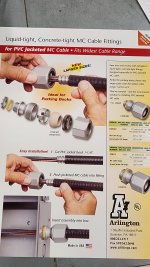Will Low voltage work for the pool table operation? If so, I wouldn't run any "normal" voltage wiring in such a scenario as "someone" later will see a 12 or 14 wire and say "hey let's use this wire" such as UF cable. UF can be used as low voltage class 2 or 3. But, UF is not allowed embedded in concreted anyway, 340.12(8).
My Question would be Who goofed? If power was going to be needed at the pool tables why wasn't it run before the tile guys came?
4" is kind of deep to cut into a grout line between tiles. Even if Low voltage cable was used it still would require some sort of protection as it enters and exits the floor.
Only wiring that I'm aware of that comes close to meeting specs for low voltage direct concrete encasement would seem to be PLTC-ER type cable. But smallest I've found was the 20awg 8 pairs and still over 1/2" diameter.
Pop tiles up, cut trench in concrete, run raceway, and wire up. Then refill with concrete and tile. Owner may not like the option but if they want power to the pool tables,

.


